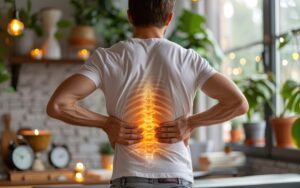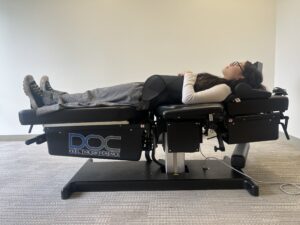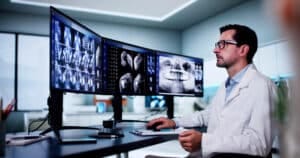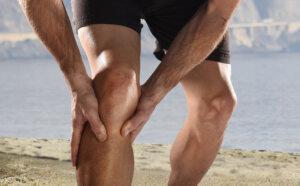A herniated disc, also known as a slipped disc, is a relatively common condition. It can occur on any part of the spine, but most often affects the lower back or neck region.
Herniated disk most commonly develops as a result of the normal aging process. Other causes include overuse and trauma to the spine. Genetic factors also
In most cases, a small herniated disc will heal within six months with self-care measures. Treatment options include chiropractic, physical therapy, acupuncture, joint injections, and surgery.
What Is Disc Pain?
Spinal discs are cushion-like pads placed between the vertebrae. They act as shock absorbers protecting the spine by absorbing the impact of trauma and body weight and prevent the bones in the spine from grinding against one another. They also are responsible for the spine’s flexibility and make movements such as bending and twisting possible.
Each disc has two components: a strong outer layer called annulus fibrosus and a soft, gel-like center called nucleus pulposus. A herniated disc occurs when the outer layer tears or ruptures and the gel-like center leaks out of it, into the spinal canal. When this happens, protruded disc causes compression on the nerves or spinal cord and causes nerve inflammation by releasing chemical irritants, which is manifested as intense, disabling pain and alterations in sensation.
Usually, over time, the herniation shrinks, which leads to partial or complete pain relief.
To get to the root cause of pain and discomfort, schedule an initial consultation, including a comprehensive evaluation and first treatment.
Types of Herniation
- Posterolateral Disc Herniation – Protrusion is usually posterolateral into the vertebral canal, compress the roots of a spinal nerve. Protruded disc usually compresses next lower nerve as that nerve crosses the level of the disc in its path to its foramen. (eg. protrusion of fifth lumbar disc usually affects S1 instead)
- Central (Posterior) Disc Herniation – Less frequently, a protruded disc above second lumbar vertebra may compress spinal cord itself or may result in cauda equina syndrome. In the lower lumbar segments, a central herniation may result in S1 radiculopathy
- Lateral Disc Herniation – May compress the nerve root above the level of the herniation. The L4 nerve root is most often involved and the patient typically has intense radicular pain.
What Causes A Herniated Disc?
Sometimes discs can bulge or herniate spontaneously. Aging plays probably the most important role, but genetics, smoking, and a number of physical activities may lead to early disc degeneration.
The most common causes of herniated disc include:
- Practicing Poor Posture – Improper spinal alignment while sitting, standing, or lying down strains the back and neck.
- Wear and Tear Changes – over the years discs dry out and aren’t as flexible as they once were.
- Repetitive Movements – Frequent bending, twisting, lifting, and other similar activities without breaks and proper stretching can leave the discs damaged. Work, lifestyle, and certain sports activities (golf) put extra stress on the spine, especially the lower back, and cause further weakening of the discs.
- Heavy Lifting and Lifting The Wrong Way – You can read about proper lifting techniques on our blog, and make sure you are doing everything correctly.
- Traumatic Injury – Commonly occurs when lifting while bent at the waist, rather than lifting with the legs while the back is straight. Any trauma on the spine wears a risk of disc damage.
- Living a Sedentary Lifestyle – Individuals who rarely if ever engage in physical activity are more prone to herniated discs because the muscles that support the back and neck weaken, which increases strain to the spine.
- Obesity – Spinal degeneration can be quickened as a result of the burden of supporting excess body fat.
- Tobacco Abuse – The chemicals commonly found in cigarettes can interfere with the disc’s ability to absorb nutrients, which results in the weakening of the disc.
- Genetics – researches have shown that there are some genes that are more commonly present in individuals with disc degeneration
What Are The Symptoms?
Herniated disk symptoms may vary depending on the location of the herniation and severity of the injury. If the injury is minimal, little or no pain will be felt. If the disc
Pain may radiate to the arm or leg if significant nerve impingement has occurred. Example of this kind of pain is sciatica, which is caused by a herniated disc in the lumbar spine.
Herniated disc symptoms usually include:
- Dull to severe pain
- Pain like an electric shock
- Numbness, tingling or burning sensation
- Muscle weakness or cramping
- Altered reflexes
- Loss of bowel or bladder control seek emergency medical care
How Is It Diagnosed?
First, your chiropractor will ask you about your symptoms, any prior injuries or conditions, and determine if any lifestyle habits are causing the pain. The physical exam is performed in order to determine the source of the pain and seek for any muscle weakness or numbness.
Imaging tests are usually ordered to confirm the diagnosis. These include X-ray, CT-Scan, MRI, myelogram, as well as Nerve Conduction Studies (NCS) and Electromyogram (EMG). Here is what these devices look for:
X-Ray For Slipped Disk
- Narrowed disc spaces.
- Loss of cervical or lumbar lordosis.
- Compensatory scoliosis.
CT-Scan For Slipped Disk
- It can show the shape and size of the spinal canal, its contents, and the structures around it, including soft tissue.
- Bulging out disc.
MRI For Slipped Disk
- Intervertebral disc protrusion.
- Compression of a nerve root.
Myelogram For Slipped Disk
- Pressure on the spinal cord or nerves, such as herniated discs, tumors, or bone spurs.
Do Herniated Discs Go Away?
When herniation is small, discs may heal on their own through a process called resorption. This means that the disc fragments are absorbed by the body.
When treatment is needed, there are many options. Herniated disc treatment include medication, rest, chiropractic care, acupuncture, physical therapy, home exercises, hydrotherapy, steroid injections, and surgery. Even though most people suffering from herniated disc respond well to conservative treatments and do not require surgery.
According to the studies, up to 80% of the people with back pain improve in about 6 weeks after starting conservative treatment and return to normal activity.
Self-care measures are the most important part of conservative treatment. This includes: rest, putting hot and cold pads on the spine, lying on
Epidural steroid injections – When your pain is severe, steroids are injected directly in the spine. The procedure is performed under x-ray and involves an injection of corticosteroids and a local anesthetic into the epidural space of the spine. This combination will reduce the swelling and inflammation of the nerves. The results tend to be temporary and better when done in conjunction with a chiropractic care, physical therapy and/or home exercise program.
Chiropractors can help you with easing the symptoms of a herniated disc, so it is important to consult one if you have this problem. Your San Francisco Chiropractor most likely will use spinal manipulation or spinal adjustment. In addition, he or she may also use ultrasound therapy and interferential electric stimulation.
Acupuncture can also help. Acupuncture may relax your muscles and relieve some of the pain.
Physical therapists can instruct you on proper posture, lifting, and walking techniques, and they can teach you exercises to strengthen your lower back, leg, and stomach muscles, and also encourage you to stretch and increase the flexibility of the spine.
Surgery treatments are an option if herniated disc symptoms do not significantly improve with conservative treatments. Herniated disc surgery may also be recommended if there are signs of nerve damage, such as weakness or loss of feeling in your legs. Most people with a herniated disc do not require surgical treatment.
You’ll find these resources useful.
How To Prevent A Herniated Disc
- Proper lifting and bending techniques
- Good posture during sitting, standing, moving, and sleeping
- Appropriate exercise program
- An ergonomic work area
- Healthy weight
- A positive attitude and stress management
- No smoking
Our success rates are very high. If you are looking for herniated disc pain relief and would like to find out if you are a candidate for our treatment we would like to meet you. To get to the root cause of pain and discomfort, schedule an initial consultation, including a comprehensive evaluation and first treatment.




